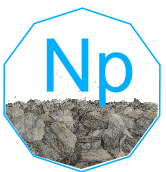Neptunium

Neptunium (Np)
General Information
- Symbol: Np
- Atomic Number: 93
- Atomic Weight: 237 u
- Element Category: Actinide
- Group: N/A (Actinides series)
- Period: 7
- Block: f-block
Physical Properties
- Appearance: Silvery metallic, tarnishes when exposed to air
- Density: 20.45 g/cm³
- Melting Point: 644 °C (1191 °F)
- Boiling Point: 4174 °C (7545 °F)
- Phase at STP: Solid
- Electron Configuration: [Rn] 5f⁴ 6d¹ 7s²
- Oxidation States: +5 (most common), +3, +4, +6, +7
Chemical Properties
- Reactivity: Neptunium is reactive, forming a variety of compounds primarily in the +5 oxidation state. It reacts with oxygen, water, and acids.
- Compounds: Forms compounds such as neptunium dioxide (NpO₂), neptunium(V) fluoride (NpF₅), and neptunium(VI) fluoride (NpF₆).
Uses and Applications
- Scientific Research: Primarily used for research purposes due to its radioactive nature.
- Nuclear Reactors: Studied for use as a potential fuel in fast neutron reactors and for breeding plutonium-238.
- Radioisotope Thermoelectric Generators (RTGs): Neptunium-238 can be used to generate power in space missions.
Occurrence and Extraction
- Natural Occurrence: Neptunium is not found in significant quantities in nature but is produced in trace amounts in uranium ores through neutron capture.
- Production: Produced synthetically in nuclear reactors from uranium-238 by neutron capture and subsequent beta decay.
Isotopes
- Stable Isotopes: Neptunium has no stable isotopes.
- Radioactive Isotopes: The most common isotopes are Neptunium-237 (half-life of 2.14 million years) and Neptunium-239 (half-life of 2.356 days).
Safety and Handling
- Hazards: Neptunium is highly radioactive and poses significant health risks. It can accumulate in bones and pose a long-term radiological hazard.
- Precautions: Handle with extreme care, using appropriate protective equipment and working in well-ventilated, controlled environments. Proper disposal of radioactive materials is crucial.
History
- Discovery: Discovered by Edwin McMillan and Philip H. Abelson in 1940.
- Name Origin: Named after the planet Neptune, following the tradition of naming elements after planets.
Additional Facts
- Crystal Structure: Orthorhombic
- Magnetic Properties: Paramagnetic
- Thermal Conductivity: 6.3 W/m·K
- Electrical Resistivity: 1.22 µΩ·m at 20°C
Summary
Neptunium is a highly radioactive actinide used primarily for scientific research. It is produced synthetically in nuclear reactors and has potential applications in nuclear technology and space exploration. Discovered in 1940 and named after the planet Neptune, neptunium requires careful handling due to its significant health risks.
40 Question and Answer Pairs About Neptunium
What is the atomic number of Neptunium?
- 93
What is the symbol for Neptunium?
- Np
What is the atomic weight of Neptunium?
- 237 u
In which group of the periodic table is Neptunium found?
- Actinides series (no specific group)
What period is Neptunium in?
- Period 7
What block does Neptunium belong to?
- f-block
What is the density of Neptunium?
- 20.45 g/cm³
What is the melting point of Neptunium?
- 644 °C (1191 °F)
What is the boiling point of Neptunium?
- 4174 °C (7545 °F)
What is the electron configuration of Neptunium?
- [Rn] 5f⁴ 6d¹ 7s²
What are the common oxidation states of Neptunium?
- +5 (most common), +3, +4, +6, +7
What is the appearance of Neptunium?
- Silvery metallic
Is Neptunium reactive with air?
- Yes, it tarnishes when exposed to air.
Name a compound of Neptunium.
- Neptunium dioxide (NpO₂)
What is a common use of Neptunium in research?
- Studied for nuclear fuel applications and breeding plutonium-238.
How is Neptunium used in nuclear reactors?
- Potential use as a fuel in fast neutron reactors.
What role does Neptunium play in space missions?
- Used in Radioisotope Thermoelectric Generators (RTGs) for power generation.
How is Neptunium typically found in nature?
- In trace amounts in uranium ores through neutron capture.
What is the most common isotope of Neptunium?
- Neptunium-237
How is Neptunium produced?
- Synthetically in nuclear reactors from uranium-238 by neutron capture.
What safety hazard is associated with Neptunium dust?
- It is highly radioactive and poses significant health risks.
Who discovered Neptunium?
- Edwin McMillan and Philip H. Abelson
Where does the name Neptunium come from?
- Named after the planet Neptune.
What is the crystal structure of Neptunium at room temperature?
- Orthorhombic
Is Neptunium paramagnetic or diamagnetic at room temperature?
- Paramagnetic
What is the thermal conductivity of Neptunium?
- 6.3 W/m·K
What is the electrical resistivity of Neptunium at 20°C?
- 1.22 µΩ·m
What is the primary oxidation state of Neptunium in its compounds?
- +5
Is Neptunium found as a free element in nature?
- No, it is found in trace amounts in uranium ores.
What is the common name of Neptunium(V) fluoride?
- NpF₅
What is a major application of Neptunium in space technology?
- Used in RTGs for power generation in space missions.
How does Neptunium benefit the nuclear industry?
- Potential fuel for fast neutron reactors and breeding plutonium-238.
What is the melting point of Neptunium in Kelvin?
- 917 K
What group does Neptunium belong to in the periodic table?
- Actinides series
What is the natural abundance of Neptunium-237?
- It is produced synthetically and is not found naturally in significant amounts.
Can Neptunium be used in high-temperature applications?
- Yes, but its radioactivity limits practical applications.
What is the key property that makes Neptunium valuable in research?
- Its radioactive properties and potential use in nuclear technology.
How is Neptunium used in the chemical industry?
- Mainly in research and specialized applications.
What precautions should be taken when handling Neptunium?
- Use appropriate protective equipment to avoid inhalation or ingestion.
What are the health risks associated with Neptunium?
- It can accumulate in bones and pose a long-term radiological hazard.






